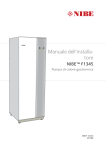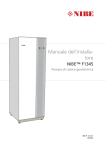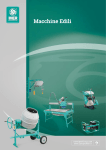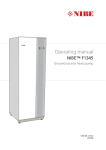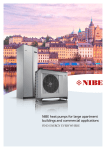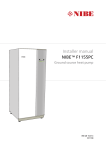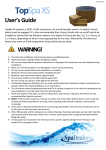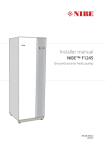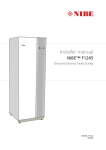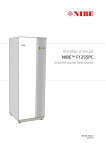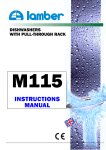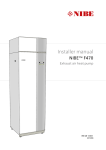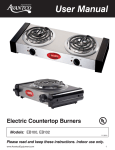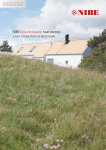Download 2 stage heat pump with rock, earth, lake or ground water as
Transcript
NIBE™ F1345 GROUND SOURCE HEAT PUMP 2 stage heat pump with rock, earth, lake or ground water as heat source. • L ess than 3 kg refrigerant per cooling section/installation. This means no inspection requirement. • T he two scroll compressors can supply up to 65°C to the heating system. • ouble compressors give better power control, longer operD ating intervals, less wear and greater operational security. • Display unit with easy-to-read colour screen. • – See status and make settings via SMS with the SMS 40 accessory. – Control the heat pump externally, with for example BMS, via the accessory MODBUS 40. • T he heat pump is available in the following sizes: 24, 30, 40 and 60 kW. • Up to 540 kW with 9 x F1345 in the same system. • Soft start relays and load monitor factory installed. • Internally installed low energy circulation pumps (not brine pump for 40 or 60 kW). • Prepared for pool heating with POOL 40 accessory. • P repared for control of up to four heating systems with ECS40/ECS41 accessory. • Coefficient Of Performance (COP) up to 4.51 at 0/35 C according to EN 14511. • S eparate cooling modules for compressors and brine pumps give reliable service and lower noise levels. • Easy to remove the cooling modules. NIBE F1345 NIBE™ F1345 is a heat pump for heating large buildings, such as apartment buildings, churches and industrial premises. F1345 is a flexible product with advanced control equipment and can be adapted to several system solutions. The ground, bedrock or lakes can be used as the heat source. Groundwater can also be used as a heat source, but this requires an intermediate heat exchanger. Another area of use could also be ventilation recovery in multioccupancy buildings. F1345 can control up to four different climate systems (requires accessory), for example a lower flow temperature in the underfloor heating loops than in the radiators. F1345 is also prepared for control of an external additional heater. At hot water production this can be prioritised, selectable with one or more compressors. This permits simultaneous production of heat and hot water. INSTALLATION METHOD The term “ground source” covers four different heat sources: rock, surface soil, ground water and lake. Rock - using a ground probe Surface soil - using a surface collector Ideal for refurbishment or adaptation from a fossil fuel heating system. Cost-effective energy collection. In the lower subsoil of the so-called “near-surface geothermal layer” lies a heat source with an almost constant temperature that can be utilised all year round. The heat pump collects stored solar energy from a collector in a hole drilled into the rock. The depth of the hole can vary between 90 – 200 metres, depending on the size of heat pump selected. This type of system can be used for all possible building types, large or small, public or private. It requires little space and the ground probe can be drilled in the smallest of gardens. During the summer, solar heat is stored in the soil. This is either directly absorbed as insulation or as heat from rain and the air from the near-surface layer of the soil. The heat pump collects this stored solar energy from a buried collector. That is, a hose filled with anti-freeze, and buried at a depth of about 80 – 100 cm, the length of the hose varies between 250 and 400 metres, depending on the size of heat pump selected. Using this energy for heating is a cost effective method. The highest yield can be obtained from soil with a high water content. Ground water Lake collector A viable energy source for any building where ground water is easily accessible. Cost-effective installation for lakeside homes. Ground water can also be utilised as a heat source since it has a temperature of between 4 and 12°C all-year round. The heat pump collects stored solar energy from the ground water. Normally, there is one well for drawing up water and one for returning it. If your home is built beside a water source such as a lake, heat from the lake water can be extracted using a surface soil collector anchored to the bottom of the lake. 2 NIBE F1345 How does F1345 work? Principle of operation F1345 consists of two heat pump modules (cooling module), circulation pumps and control system with possibility of additional heat. F1345 is connected to the brine and heating medium circuits. In the heat pump evaporator, the brine (water mixed with antifreeze, glycol or ethanol) releases its energy to the refrigerant, which is vaporised in order to be compressed in the compressor. The refrigerant, of which the temperature has now been raised, is passed to the condenser where it gives off its energy to the heating medium circuit and, if necessary, to any docked water heater. If there is a greater need for heating/hot water than the compressors can provide it is possible is to connect an external immersion heater. Brine to heat pump Brine from heat pump F1345 is extremely efficient thanks to a highly effective compressor in well dimensioned refrigerant circuits. Internally installed low energy circulation pumps and flex hoses (not brine pump for 40 or 60 kW). The brine respectively heating medium circuits are connected from the rear of the heat pump. Particle filter supplied. The heat pump can be connected to an optional low temperature distribution system. e.g. radiators, convectors or under floor heating. F1345 is equipped with a control computer for optimum and reliable operation. A large backlit TFT display shows information about status, operating time and all temperatures in the heat pump as well as certain information about any slave heat pumps, in colour using icons and text. F1345 is constructed on a robust frame with durable panels and effective soundproofing for the best possible comfort. All panels are easy to remove for easy access when installing and for servicing. Sleeve pipe Ground water level Active borehole (water column in rock) 24-30kW 40kW Brine pump* 60kW Compressor Brine in Heating medium supply Brine out Cooling module EP15 Heating medium return Circulation pump Brine pump* Compressor Brine in Heating medium supply Brine out Heating medium return Cooling module EP14 Expansion valve Condenser Circulation pump Evaporator * The brine pump (1 x) for 40 or 60 kW is supplied and installed externally outside the heat pump. NIBE F1345 3 Good to know about NIBE™ f1345 Transport and storage Assembly F1345 should be transported and stored vertically in a dry place. • Position F1345 on a firm base that can take the weight, preferably on a concrete floor or foundation. Use the heat pump’s adjustable feet to obtain a stable set-up. • Install with its back to an outside wall, ideally in a room where noise does not matter, in order to eliminate noise problems. If this is not possible, avoid placing it against a wall behind a bedroom or other room where noise may be a problem. • Wherever the unit is located, walls to sound sensitive rooms should be fitted with sound insulation. • Route pipes so they are not fixed to an internal wall that backs on to a bedroom or living room. When being moved into a building, F1345 may be leant back 45 °. NOTE! The heat pump is top heavy. If the cooling modules are pulled out and transported upright, F1345 can be transported on its back. The side panels can be removed for easier installation in the building. NOTE! Ensure that the heat pump cannot fall over during transport. 0 R H M flo w4 9 (5 0°C ) H o t w a te r 5 1°C -2 0 +2 1 0 R R 1 +2 0 -2 H M flo w4 9 (5 0°C ) H o t w a te r 5 1°C Drawing out the cooling module 0 Leave a space of 800 mm in front of the heat pump. Approximately 50 mm free space is required on each side in order to open the side hatches. The hatches do not need to be opened during service, all service on F1345 can be carried out from the front. There must be at least 300mm of free space above the heat pump. Leave space between the heat pump and wall behind (and any routing of supply cables and pipes) to reduce the risk of reproduction of any vibration. R 0 Installation area To simplify transport and service, the heat pump can be separated by pulling the cooling module out from the cabinet. See the installer manual for comprehensive instructions about the separation. * (50) (50) * 800 LEK * A normal installation needs 300 - 400 mm (any side) for connection equipment, i.e. level vessel, valves and electrical equipment. 4 NIBE F1345 Good to know about NIBE™ f1345 Dimensions 450 560 25-50 1715 735 1555 1775 820 620 85 440 80 145 145 145 600 NIBE F1345 5 Good to know about NIBE™ f1345 Equipment X2 X3 X4 X5 X6 UB3 UB2 UB1 X7 FC1 UB3 EP15-XL1 AA4 UB2 PF1 EP15-PF2 PF3 EP15-XL2 EP15-XL7 SF1 EP15-XL6 EP15-FB1 EP15-AA10 EP15 EP14-XL1 EP14-XL2 EP14-XL7 EP14-PF2 EP14-XL6 EP14-FB1 EP14-AA10 EP14 LEK UB1 AA2 X1 AA26 AA7 AA3 FC1 LEK Cooling section F1345 24 and 30 kW Cooling section F1345 40 and 60 kW EP2 EP2 EP1 BT12 GQ10 EP1 BT12 GQ10 AA100 AA100 BT10 GP1 BT3 GP2 6 NIBE F1345 BT10 GP1 BT3 K LE BT11 K LE QM1 QM1 QM2 QM2 BT11 good to know about NIBE™ F1345 Pipe connections X1 Terminal block, incoming electrical supply XL1 Connection, heating medium flow X2 XL2 Connection, heating medium return XL6 Connection, brine in T erminal block, non-return valve, external brine pump (only 40 and 60 kW) and external operating voltage (at tariff control) XL7 Connection, brine out X3 Terminal block, step controlled additional heat X4 Terminal block, emergency mode relay HVAC components X5 Terminal block, buzzer alarm EP14 X6 T erminal block, communication, software controlled inputs X7 Terminal block, control signal external brine pump (only 40 and 60 kW) Cooling module EP15 Cooling module GP1 Circulation pump GP2 Brine pump QM1 Drainage, climate system QM2 Draining, brine side Cooling components EP1 Evaporator EP2 Condenser GQ10 Compressor Sensors etc. BT1 Temperature sensor, outdoor BT10 Temperature sensor, brine in BT11 Temperature sensor, brine out BT12 Temperature sensor, condenser supply line sensors and Miscellaneous PF1 Rating plate PF2 Type plate, cooling section PF3 Serial number plate UB1 Cable gland, incoming electricity UB2 Cable gland, power UB3 Cable gland, signal Designations in component locations according to standard IEC 81346-1 and 81346-2. Electrical components AA2 Base card AA3 Input circuit board AA4 Display unit AA7 Extra relay circuit board AA10 Soft-start card AA26 Base card 2 AA100 Joint card FC1 Miniature circuit-breaker FB1 Motor cut-out SF1 Switch NIBE F1345 7 Good to know about NIBE™ f1345 Pump capacity diagram Heating medium side 24 kW 30 kW External available pressure, kPa External available pressure, kPa Externt tillgängligt tryck kPa Externt tillgängligt tryck kPa 90 90 80 80 70 70 60 60 50 50 40 40 100% 100% 80% 80% 30 20 10 0 60% 0,2 0,4 0,6 0,8 1,2 1,4 1,6 1,8 2,0 0 80% 60% 60% 10 40% 1,0 100% 80% 20 60% 40% 0 100% 30 40% 40% 0 0,2 0,4 0,6 0,8 1,0 1,2 1,4 1,6 Flöde, Flow, l/s l/s 22 cirkulationspumpar circulation pumps 11 cirkulationspump circulation pump Electrical output per circulation pump, W Electrical output per circulation pump, W Eleffekt per cirkulationspump 100 Eleffekt per cirkulationspump W W 90 100% 90 100% 80 80 80% 70 80% 70 60 60 50 50 60% 60% 40 40 30 30 40% 20 20 10 10 0 0,1 0,2 0,3 0,4 0,5 0,6 0,7 0,8 0,9 1,0 0 40% 0 0,1 0,2 0,3 0,4 0,5 Flöde, Flow, l/s l/s 0,6 0,7 0,8 0,9 1,0 Flöde, l/s l/s Flow, GP1 K LE The pump is adjustable, the flow can be adjusted in menu 5.1.11. 8 NIBE F1345 2,0 22 cirkulationspumpar circulation pumps 11 cirkulationspump circulation pump 100 0 1,8 Flöde, Flow, l/sl/s good to know about NIBE™ F1345 40 kW 60 kW External available pressure, kPa External available pressure, kPa Externt tillgängligt tryck 100 100 90 90 80 80 70 70 60 60 50 50 Externt tillgängligt tryck kPa kPa 40 40 100% 30 20 100% 20 10 0 30 40% 0 0,2 0,4 0,6 0,8 80% 60% 80% 1,0 40% 100% 1,2 1,4 60% 1,6 1,8 2,0 10 0 40% 0 0,2 0,4 0,6 0,8 80% 60% 40% 80% 100% 1,0 1,2 1,4 60% 1,6 1,8 Flöde, Flow, l/sl/s 2 cirkulationspumpar 2 circulation pumps 1 cirkulationspump 1 circulation pump 22 cirkulationspumpar circulation pumps 11 cirkulationspump circulation pump Electrical output per circulation pump, W Eleffekt per cirkulationspump Electrical output per circulation pump, W 100 100 Eleffekt per cirkulationspump W W 100% 90 80 80% 100% 90 80 70 70 60 60 80% 50 50 60% 40 60% 40 30 30 40% 40% 20 20 10 10 0 2,0 Flöde, Flow, l/sl/s 0 0,1 0,2 0,3 0,4 0,5 0,6 0,7 0,8 0,9 1,0 0 0 0,2 0,4 Flöde, Flow, l/sl/s 0,6 0,8 1,0 1,2 Flöde, Flow, l/s l/s GP1 K LE The pump is adjustable, the flow can be adjusted in menu 5.1.11. NIBE F1345 9 Good to know about NIBE™ f1345 Pump capacity diagram Brine side 24 kW 30 kW External available pressure, kPa External available pressure, kPa Externt tillgängligt tryck kPa Externt tillgängligt tryck kPa 120 140 120 100 100 80 80 60 60 40 100% 100% 20 0 100% 80% 80% 60% 40% 0 0,5 60% 1,5 2,0 2,5 0 Flöde, Flow, l/s l/s 60% 40% 40% 0 22 cirkulationspumpar circulation pumps 11 cirkulationspump circulation pump 0,5 60% 1,0 Electrical output per circulation pump, W 2,0 2,5 Flöde, l/s l/s Flow, Electrical output per circulation pump, W Eleffekt per cirkulationspump W Eleffekt per cirkulationspump W 200 180 180 100% 160 160 140 140 120 100% 80% 120 80% 100 100 80 80 60 60 60% 40 20 0 0,2 0,4 60% 40 20 40% 0,6 0,8 GP2 1,0 1,2 1,4 Flöde, Flow, l/s l/s 0 40% 0 0,2 0,4 0,6 K LE The pump is adjustable, the flow can be adjusted in menu 5.1.9. 10 NIBE F1345 1,5 2 2cirkulationspumpar circulation pumps 1 1cirkulationspump circulation pump 200 0 100% 80% 20 80% 40% 1,0 40 0,8 1,0 1,2 1,4 Flow, Flöde, l/s l/s good to know about NIBE™ F1345 40 kW 60 kW External available pressure, kPa External available pressure, kPa Externt tillgängligt tryck kPa Externt tillgängligt tryck kPa 180 180 160 160 140 140 120 120 100 100 3 80 80 60 60 2 40 3 40 20 2 1 20 1 0 0 0,2 0,4 0,6 0,8 1,0 1,2 1,4 1,6 1,8 2,0 2,2 2,4 0 0 0,5 1,0 1,5 2,0 2,5 3,0 Flöde, Flow, l/sl/s Electrical output per circulation pump, W 3,5 Flöde, l/s Flow, l/s Electrical output per circulation pump, W Eleffekt per cirkulationspump kW Eleffekt per cirkulationspump kW 1,0 1,4 0,9 3 2 0,8 2 1 1 0,7 3 1,2 1,0 0,6 0,8 0,5 0,6 0,4 0,3 0,4 0,2 0,2 0,1 0 0 0,2 0,4 0,6 0,8 1,0 1,2 1,4 1,6 1,8 2,0 2,2 2,4 0 0 0,5 1,0 1,5 2,0 2,5 Flöde, Flow, l/sl/s 3,0 3,5 Flöde, Flow, l/sl/s LE K LEK The pump is adjustable, the flow can be adjusted using the speed switch on the pump. NIBE F1345 11 The display A large, easy to read multicoulour display gives everyone the chance to maximize the energy saving potential of this exciting green technology! Display unit Display, A Control knob, E Instructions, settings and operational information are shown on the display. The easy-to-read display and menu system, facilitates navigation between the different menus and options to set the comfort or obtain the information you require. The control knob can be turned to the right or left. You can: Status lamp, B • scroll in menus and between options. • increase and decrease the values. • change page in multiple page instructions (for example help text and service info). The status lamp indicates the status of the heat pump. It: • lights green during normal operation. Switch, F • lights yellow in emergency mode. The switch assumes three positions: • lights red in the event of a deployed alarm. • On () • Standby ( ) OK button, C • Emergency mode ( ) The OK button is used to: • confirm selections of sub menus/options/set values/page in the start guide. Back button, D The back button is used to: • go back to the previous menu. • change a setting that has not been confirmed. F1345 12 NIBE F1345 A Display B Status lamp C OK button D Back button E Control knob F Switch The display Menu system When the door to the heat pump is opened, the menu system’s four main menus are shown in the display as well as certain basic information. Outdoor temp. Indoor temperature - (if a room sensor is connected) Hot water temp. Menu 1 – Indoor climate Setting and scheduling the indoor climate. Menu 2 – Hot water Setting and scheduling hot water production. This menu only appears if a water heater is docked to the heat pump. Menu 3 - Info Display of temperature and other operating information and access to the alarm log. Extra hot water (if activated) Estimated amount of hot water Menu 4 – Heat pump Setting time, date, language, display, operating mode etc. Menu 5 - Service dvanced settings. These settings are not available to the user. A The menu is visible by pressing the back button for 7 seconds. Start guide The first time the heat pump is switched on a start guide is started. The start guide instructions state what needs to carried out at the first start together with a run through of the heat pump’s basic settings. The start guide ensures that the start-up is carried out correctly and cannot be bypassed. The start guide can be started later in menu 5.7. NIBE F1345 13 installation Pipe installation Pressure expansion vessel Pipe installation must be carried out in accordance with current norms and directives. F1345 can operate with a return temperature of up to 58 °C and an outgoing temperature from the heat pump of 65 °C. The brine circuit must be supplied with a pressure expansion vessel. F1345 is not equipped with shut off valves; these must be installed outside the heat pump to facilitate any future servicing. The brine side must be pressurised to at least 0.05 MPa (0.5 bar). The pressure expansion vessel should be dimensioned as set out in the following diagram, to prevent operating disturbances. The diagrams cover the temperature range from -10 °C to + 20 °C at a pre-pressure of 0.05 MPa (0.5 bar) and the safety valve's opening pressure of 0.3 MPa (3.0 bar). Pipe connection (cooling medium) Ethanol 28% (volume percent) The pipe connections are on the rear of the heat pump. In installations with ethanol (28% volume percent) as the brine, the pressure expansion vessel must be dimensioned according to the following diagram. Insulate all indoor brine pipes against condensation. Mark the brine system with the antifreeze that is used. Install the supplied safety valve at the expansion vessel as illustrated in the outline diagram. The entire length of the overflow water pipe from the safety valves must be inclined to prevent water pockets and must also be frost-free. Install shut off valves as close to the heat pump as possible so that the flow to individual cooling modules can be shut off. Extra safety valves between the particle filter and shut off valves (according the outline diagram) are required. Fit the supplied particle filter on the incoming brine pipe. Fit the supplied non-return valves on the outgoing pipe. In the case of connection to an open groundwater system, an intermediate frost-protected circuit must be provided, because of the risk of dirt and freezing in the evaporator. This requires an extra heat exchanger. Ethylene glycol 40% (volume percent) In installations with ethylene glycol (40% volume percent) as the brine the pressure expansion vessel must be dimensioned according to the following diagram. Volume pressure expansion vessel (l) 100 90 80 70 60 50 40 30 20 10 P 0 0 200 400 600 800 1000 1200 1400 1600 1800 2000 Total volume refrigerant in system (l) Ethylene glycol 40% (volume percent) In installations with ethylene glycol (40% volume percent) as the brine the pressure expansion vessel must be dimensioned according to the following diagram. Volume pressure expansion vessel (l) 60 50 40 Note! Note that condensation may drip from the level vessel. Position the vessel so that this does not harm other equipment. 30 20 10 0 0 100 200 300 400 500 600 700 800 900 1000 1100 1200 1300 1400 1500 Total volume refrigerant in system (l) 14 NIBE F1345 installation Connection of external brine pump (only 40 and 60 kW) Install the brine pump (GP16) according to the circulation pump manual for connection of incoming brine (EP14-XL6) and (EP15XL6) between the heat pump60kW and shut off valve (see image). GP16 Pipe connection (water heater) • Any docked hot water heater must be fitted with necessary set of valves. • The mixing valve must be installed if the setting is changed so that the temperature can exceed 60 °C. • The setting for hot water is made in menu 5.1.1. • The safety valve must have a maximum opening pressure in accordance with the water heater manual and be installed on the incoming domestic water line. The entire length of the overflow water pipe from the safety valves must be inclined to prevent water pockets and must also be frost-free. CAUTION! The heat pump/system is designed so that hot water production can occur with one or several cooling modules. This however entails different pipe or electrical installations. Fixed condensing If F1345 is to work towards the water heater with fixed condensing you must connect an external flow sensor (BT25) according to the description in the installer handbook In addition, menu settings must be made (see installer handbook). Pipe connection (heating medium) Connecting the climate system A climate system is a system that regulates indoor comfort with the help of the control system in F1345 and for example radiators, underfloor heating/cooling, fan convectors etc. The pipe connections are on the rear of the heat pump. Install the necessary safety equipment and shut off valves (installed as close to the heat pump as possible so that the flow to individual cooling modules can be shut off). Fit the supplied particle filter on the incoming pipe. The safety valve must have a maximum 0.6 MPa ( 6.0 bar) opening pressure and be installed on the heating medium return. The entire length of the overflow water pipe from the safety valves must be inclined to prevent water pockets and must also be frost-free. When connecting to a system with thermostats on all radiators, a relief valve must be fitted, or some of the thermostats must be removed to ensure sufficient flow. Fit the supplied non-return valves on the outgoing pipe. Install the vent valves in the climate system if necessary. CAUTION! When necessary you should install venting valves in the climate system. CAUTION! The heat pump is designed so that heating production can occur with one or two cooling modules. This however entails different pipe or electrical installations. NIBENIBE VPBF1345 200N 15 installation NIBE F1345 can be connected in several different ways, some of which are shown below. Further option information is available in the respective assembly instructions for the accessories used. F1345 docked with electric additional heat and water heater (floating condensing) The heat pump (EB100) prioritises charging of hot water with half the power (cooling module EP14) via a reversing valve (QN10). When the water heater/accumulator tank (CP10) are fully charged (EB100-QN10) switches to the heating circuit. When there is a demand for heat, cooling module (EP15) starts first. For greater demands, cooling module (EP14) also starts for heating operation. Additional heat (EB1) is connected automatically when the energy requirement exceeds the heat pump capacity. If the water heater/accumulator tank (CP10) is fitted with an immersion heater (EB2) and a junction box (XD1) and the accessory card AXC 50 (AA5), the functions "temporary lux" and "periodic increase" can be used. A by-pass contactor is recommended. -EB1 -FL10 -CM5 -EB1 -QM42 -GP10 -QM43 -RN11 -RM42 -BP6 P -QM21 -FL3 -EB100 -CM3 -QM33 -XL27 -XL28 -QM34 -BT1 -EB100 -FL12 -QM53 -QM52 -FL11 -QM51 -QM50 -EP12 -HQ13 -EP15 -HQ15 -RM11 -QM56 -FL14 -HQ12 -RM10 -EP14 -KA1 -HQ14 -QM54 -FL13 -CM1 -QM20 -CP10 -EB100 -BT6 -AA5 -RM12 -QM55 -QM11 -FL2 16 NIBE F1345 -EB100 -QN10 -RM13 -QM57 -XD1 -EB2 -EB100-BT25 -EB100-BT71 installation x F1345 docked with oil addition, pool and water heater 2 (floating condensing) The heat pump (EB100) prioritises charging of hot water with half the power (cooling module EP14) via a reversing valve (EB100-QN10). When the water heater/accumulator tank (CP10 and CP11) are fully charged (EB100-QN10) switches to the heating circuit. The other half of the output (cooling module EP15) prioritises pool heating via a reversing valve (CL11-QN19). When the pool is heated (CL11-QN19) switches to the heating circuit. When there is a demand for heat, cooling module (EP15) starts in heat pump (EB101) first. For greater demands, cooling module (EP14) also starts in (EB101) for heating operation. Additional heat (EM1) is connected automatically when the energy requirement exceeds the heat pump capacity. If the water heater/accumulator tank (CP10) is fitted with an immersion heater and a junction box the function "temporary lux" is used. A by-pass contactor is recommended. -EM1 -EP21 -AA5 -FL10 -CM5 -KA1 -AA5 -BT52 -EM1 -QN11 -CL11 -EB101 -AA5 -HQ13 -QM53 -QM52 -FL12 -QM50 -FL11 -EP15 -RM11 -HQ12 -QM51 -EP14 -RM13 -QM57 -HQ15 -QM56 HQ14 -RM10 -XL28 -QM34 -QM52 -FL12 -RM11 -QM51 -HQ12 -QM50 -FL11 -RM10 -EP12 -EP14 -BT51 POOL -HQ41 -GP11 -RN60 -EB100 -EP15 -GP9 -AA5 -RN61 -HQ13 -EP5 -RN42 -QM54 -EB100 -BT1 -QM53 -QN19 -FL14 -RM12 -QM55 -FL13 -XL27 -EB100-BT71 -EB101 -CM3 -QM33 -GP20 -BT3 -GP10 -EB100-BT25 -RM42 -BP6 P -QM21 -FL3 -BT2 -QN25 -RM13 -QM57 -HQ15 -QM56 -EB100 -CP10 -QN10 -RN63 -RN41 -RM43 -FQ1 -BT70 -RN62 -CP11 -EB10 -EB100 -BT6 -FL14 -QM55 -RM12 -HQ14 -QM54 -FL13 -QM11 -FL2 -QM20 -CM1 NIBE F1345 17 installation Inspection of the installation Control, general Current regulations require the heating installation to be inspected before it is commissioned. The inspection must be carried out by a suitably qualified person and should be documented. The above applies to closed heating systems. If the heat pump is replaced, the installation must be inspected again. The indoor temperature depends on several factors. Sunlight and heat emissions from people and household machines are normally sufficient to keep the house warm during the warmer parts of the year. When it gets colder outside, the climate system must be started. The colder it is outside, the warmer radiators and floor heating system must be. Guideline values for collectors Type Surface ground heating, recommended collector length Ground-source heating, recommended active drilling depth 24 3x350 – 3x400 m 2x180 – 3x180 m 30 3x450 – 4x450 m 3x150 – 5x150 m 40 4x500 – 6x500 m 4x170 – 5x200 m 60 6x450 – 8x450 m 6x150 – 8x180 m For use with 40 x 2.4 PN 6.3 PEM hose. This are rough example values. On installation the correct calculations must be made according to local conditions. The length of the collector hose varies depending on the rock/soil conditions, climate zone and on the climate system (radiators or underfloor heating). Max length per coil for the collector should not exceed 500 m. The collectors must always be connected in parallel with the possibility of adjusting the flow for the relevant coil. For surface soil heat, the hose should be buried at a depth of about 1 metre and the distance between the hoses should be at least 1 metre. For several bore holes, the distance between the holes must be at least 15 m. Ensure the collector hose rises constantly towards the heat pump to avoid air pockets. If this is not possible, air vents should be used. As the temperature of the brine system can fall below 0 °C it must be protected against freezing down to -15 °C. One litre of ready mixed brine per meter of collector hose (applies when using PEM-hose 40 x 2.4 PN 6.3) is used as a guide value when making the volume calculation. 18 NIBE F1345 The heat pump is controlled by built-in sensors for flow and return brine temperatures (collector). Brine return temperatures can, if so required, be limited to a minimum (e.g. for ground water systems). Control of the heat production is performed based on the "floating condensing" principle, i.e. the temperature level needed for heating at a specific outdoor temperature is produced guided by collected values from the outdoor and flow sensors. The room temperature sensor can also be used to compensate the deviation in room temperature. F1345 can be docked to an external unit with its own heating controls. In that case, the heat pump delivers heat up to a fixed temperature level. This is known as “Fixed condensing”. The automatic heating control system is then controlled by the external unit’s regulation device. installation Basic functions Heat production Brine pump LE K F1345 is equipped with an outdoor temperature controlled heating control system. This means that the supply of heat to the house is regulated in accordance with the chosen setting of the regulating curve (curve slope and offset). After adjustment, the correct amount of heat for the outside temperature is supplied. The flow line temperature of the heat pump will hunt around the theoretically required value. For subnormal temperatures the control system calculates a heating deficit in the form of "degreeminutes" which means that heating production is accelerated. The larger the subnormal temperature, the greater the heat production. LE K Heat production can take place with one or several compressors. The brine pumps (40 or 60 kW have 1 brine pump) normally follow the operation of the heat pump. There is a special operating mode for continuous operation for 10 days, followed by return to normal mode (this may be used before stable circulation has been established). Alarm indications The status lamp lights red in the event of an alarm and the display shows detailed information depending on the fault. An alarm log is created with each alarm containing a number of temperatures, times and the status of outputs. Additional heat only F1345 can be used exclusively with an additional heater to produce heat, for example before the collector installation is complete. Hot water production This function requires accessory VST 20. Room control If the water heater is docked to F1345 when there is a demand for hot water, the heat pump gives this priority and devotes half its output to water heating. Heating is produced by the second compressor in this mode. Maximum time for hot water charging can be adjusted in the menu system. After this, heating is produced by both the compressors for the remaining period of time before further water heating can take place. LE K With two or more compressors connected for water heating this is engaged and disengaged automatically by the control system on demand. A reversing valve is required for each F1345 that is to charge hot water. Hot water charging starts when the hot water sensor has fallen to the set start temperature. Hot water charging stops when the hot water temperature on the hot water sensor (BT6) has been reached. For occasional higher demand for hot water, the temporary lux function can be used to raise the temperature for 3 – 12 hours (selected in the menu system). Own curve F1345 has pre-programmed non linear heating curves. It is also possible to create your own defined curve. This is an individual linear curve with one break point. You select a break point and the associated temperatures. F1345 can be supplemented with a room sensor (BT50). The room temperature sensor has up to three functions: 1. Show current room temperature in the heat pump's display. 2. Option of changing the room temperature in °C. 3. Makes it possible to change/stabilise the room temperature. Install the sensor in a neutral position where the set temperature is required. A suitable place is on a free inner wall in a hall approx. 1.5 m above the floor. It is important that the sensor is not obstructed from measuring the correct room temperature by being located, for example, in a recess, between shelves, behind a curtain, above or close to a heat source, in a draft from an external door or in direct sunlight. Closed radiator thermostats can also cause problems. The heat pump operates without the sensor, but if one wishes to read off the accommodation's indoor temperature in F1345's display the sensor must be installed. External control (AUX input) F1345 can be controlled using signals from external systems (for example DUC) connected to three software controlled inputs (AUX inputs). The alarm and time conditions in F1345 override the external control. The following functions can be controlled: • Blocking of the compressors -EP14 and -EP15 • Blocking additional heat • Blocking heating Under floor drying • Tariff blocking F1345 has an integrated floor drying function. This allows for controlled drying of a concrete slab. It is possible to create your own program and to follow a pre-programmed time and temperature schedule. • Activation of temporary lux (extra hot water) • External adjustment of flow temperature • Forced control of brine pump(s) • Activating fan speed (requires accessory NIBE FLM) All control signals should occur with potential-free relays. NIBE F1345 19 installation Step controlled additional heat Load monitor Heat pumps are not usually dimensioned to provide the entire heat output requirement, which is why additional output is necessary during cold days. The external step controlled additional heater (if connected) is automatically switched on (in different steps) if the output is not sufficient to reach the temperature levels requested by the control computer. When many power consumers are connected in the property at the same time as the electric additional heat is operating, there is a risk of the property's main fuse tripping. The heat pump has integrated load monitors that control the electrical steps for the electrical additional heat by disconnecting step by step in event of overload in a phase. Reconnection occurs when other current consumption is reduced. F1345 provides 230 V control signals for the additional heat, that is signals for controlling external relays, contactors etc, but not to supply them with power. External step controlled additional heat can be controlled by up to three potential free relays in the heat pump (3 step linear or 7 step binary). With the AXC 50 accessory a further three potential free relays are used for addition control, which then gives max 3+3 linear or 7+7 binary steps. Step in occurs with at least 1 minute interval and step outs with at least 3 seconds interval. A current sensor should be installed on each incoming phase conductor in to the distribution box to measure the current. The distribution box is an appropriate installation point. USB service outlet F1345 is equipped with a USB socket in the display unit. This USB socket can be used to connect a USB memory stick to update the software, save logged information and handle the settings in F1345. Master/Slave Several heat pumps (F1345) can be interconnected by selecting one heat pump as master and the others as slaves. The heat pump is always delivered as master and up to 8 slaves can be connected to it and supply up to 540 kW (with 9 x F1345 60 kW) in the same system. In systems with several heat pumps each pump must have a unique name, that is only one heat pump can be "Master" and only one can be for example "Slave 5". Software controlled output (AUX output) It is possible to have an external connection through the relay function via a potential free variable relay (max 2 A) on the X5 terminal block. Optional functions for external connection: • Indication of buzzer alarm (preselected at the factory). • Controlling ground water pump. • ooling mode indication (only applies if accessories for cooling are C present or if the heat pump has the integrated cooling function). • Control of circulation pump for hot water circulation. • External circulation pump (for heating medium). • If any of the above is installed to terminal block X5 it must be selected in the control system. The accessory card is required if two or more of the above functions are to be connected to terminal block X5 at the same time. 20 NIBE F1345 LEK External temperature sensors and control signals must only be connected to the master, except for external control of the compressor module and reversing valve(s) (QN10) that can be connected one to each heat pump. installation Extended functions Cooling Pool The accessory AXC 50 may be needed for distribution of cooling to the climate system. This function requires accessory POOL 40. A reversing valve can be connected to control part, or all, of the heating medium flow to a pool exchanger. The reversing valve, or if so desired the reversing valves (although using the same control signal), is/are installed on the heating medium circuit which normally goes to a radiator system. You determine in the control system how many compressors are permitted to work with the pool. External circulation pump (GP10) must be installed for pool operation. Passive cooling (4-pipe) LEK During pool heating the heating medium is circulated between the heat pump and the pool exchanger using the heat pump's internal circulation pumps. The external circulation pump circulates the heating medium water in the climate system and the additional heat can be engaged as necessary at the same time as the external flow sensor continually meters the heating demand of the house. This function requires the accessory AXC 50 (an AXC 50 for each accessory function that is to be used). LEK The cooling system is connected to the heat pump collector circuit, through which cooling is supplied from the collector via the circulation pump and the shunt valve. When cooling is required (activated from the outdoor sensor and any room sensor) the reversing valve and the circulation pump are activated. The shunt valve regulates so that the cooling sensor reaches the current set point value corresponding to the outdoor temperature and the set min. value for the cooling temperature (to prevent condensation). Passive/active cooling (4-pipe) HEJSAN 130 G RU N DFOS 1m(A) P,(W) 0.20 45 0.30 65 0.40 90 Type UPS 25 - 60 230V50Hz 2.5uF LEK This function requires the ECS 40/ECS 41 or AXC 50 accessory if larger separate shunt valves are needed. DK Extra climate system This function makes both heat and cooling production independently of each other possible. IP 44 TF 110 Class H Max. 10bar This function requires reversing valve for cooling, circulation pump, shunt valve and accessory ACS 45. P/N:59526447 PC;0017NIB Up to two different pool systems can be connected to F1345 and controlled individually, it does require two POOL 40-accessories. LE K A shunt valve, flow and return sensor and a circulation pump are connected to a second heating circuit with a lower temperature demand (e.g. under floor heating system). The temperature in the extra climate system is controlled by the heat pump and the shunt valve by offsetting the heat curve (each climate system has its own heat curve), room sensor or room unit. LEK Up to 3 additional climate systems can be connected to the heat pump. Hot water comfort This function requires the accessory AXC 50 which gives the possibility of temporary lux, mixing valve and hot water circulation (an AXC 50 for each accessory function that is to be used). LEK LEK The cooling system supplies cooling from the collector circuit using a circulation pump via a shunt valve. Passive cooling occurs without the compressor running, while active cooling occurs when the compressor is running. For the installation to work the heating medium must flow freely, for example using UKV. Operating mode cooling is activated by the temperature of the outdoor sensor and any room temperature sensors or room units. When cooling is required the cooling reversing valve and the circulation pump are activated. The shunt regulates according to the cooling sensor and a cooling set point value that is determined by the selected cooling curve and offset. Degree minutes are calculated in response to the value on the brine out external temperature sensor and the cooling set point value. The degree minute value determines in which cooling mode the installation is according to the menu settings. Passive cooling (2-pipe) This function requires the accessory AXC 50 (an AXC 50 for each accessory function that is to be used). Temporary lux (extra hot water) This function requires the accessory AXC 50. If an immersion heater is installed in the tank it can be permitted to produce hot water at the same time as the heat pump prioritises heating. LEK LEK Mixing valve This function requires the accessory AXC 50. A temperature sensor reads the temperature of the outgoing water to the hot water taps and adjusts the mixing valve from the hot water heater until the set temperature (in the control system) has been reached. The collector circuit is connected to a heat exchanger via a reversing valve. The other side of the exchanger is connected to the heating medium circuit via a shunt valve and a circulation pump. When cooling is required (activated from the outdoor sensor and any room sensor or room unit) the reversing valve and the circulation pump are activated. The shunt valve regulates so that the cooling sensor reaches the current set point value corresponding to the outdoor temperature and the set min. value for the cooling temperature (to prevent condensation). Hot water circulation (VVC) This function requires the accessory AXC 50. One pump can be controlled for the circulation of the hot water during selectable periods. NIBE F1345 21 installation Passive/active cooling (2-pipe) LEK The heating/cooling modes are controlled by 4 reversing valves, which, depending on the outdoor temperature and/or room temperature, switch between the different modes. The supply of cooling to the building is controlled by the set curve slope and the offset of the curve in the control system. After adjustment the correct amount of cooling for the current outdoor temperature is supplied. The flow temperature from the reversing valves will hover around the theoretical required value (settable in the control system). For excess temperatures F1345 calculates a surplus in the form of degree minutes, this results in the acceleration of cooling production the greater the excess temperature. F1345 automatically moves to cooling operation when the outdoor temperature exceeds the set value. When the cooling requirement is large and passive cooling is not sufficient, active cooling is engaged at the set limit value. A compressor then starts and the resulting cooling circulates to the building’s distribution system and the heat circulates out to the ground/rock collector. If several compressors are available these start with a difference of set degree minutes. Groundwater pump This connection enables the use of ground water as heat source. The ground water is pumped up to an intermediate heat exchanger. An intermediate heat exchanger is used to protect the heat pump's exchanger from dirt and freezing. The water is released into a buried filtration unit or a drilled well. The ground water pump runs at the same time as the brine pump. Step controlled additional heat LEK External circulation pump With the AXC 50 accessory (an AXC 50 for each accessory function that is to be used) an external circulation pump (for the climate system) can be connected to the heat pump if the alarm relay (AUX output) is activated for another function. The function is already included in the following accessory functions: • Step controlled additional heat • Shunt controlled additional heat • Pool MODBUS LE The MODBUS 40 accessory enables F1345 to be controlled and monitored in a BMS system in the building. Communication occurs using MODBUS-RTU. SMS control The SMS 40 accessory enables F1345 to be controlled and monitored using a mobile phone via SMS messaging. For this to work, SMS 40 must be equipped with a valid GSM subscription. There is no special GSM subscription requirement. A pay as you go card or a normal subscription work equally well. However a pay as you go card must be regularly topped up to ensure continued use sending SMS. LEK This connection enables an external additional heater, e.g. an oil boiler, to aid with heating. The heat pump controls a shunt valve and a circulation pump via AXC 50. If the heat pump does not manage to keep the correct flow temperature, the addition starts. When the boiler temperature has been increased to about 55°C, the heat pump sends a signal to the shunt valve to open from the addition. The shunt valve adjusts so the true flow 22 NIBE F1345 The heat pump prioritises charging from the solar panel. If the mobile telephone also has the Android operating system the ”NIBE Mobile App” can be used. In the event of an alarm, SMS 40 can send an SMS to the programmed recipient and present it graphically. Shunt controlled additional heat Accessory AXC 50 (an AXC 50 for each accessory function that is to be used) can be used to connect shunt controlled addition to the heat pump. VPB can be connected to obtain hot water charging via heat exchanger. Room unit The RMU 40 accessory enables F1345 to be controlled and monitored from a different part of the building to where the heat pump is located. LEK With the AXC 50 accessory (an AXC 50 for each accessory function that is to be used) a further three potential free relays are used for addition control, which then gives max 3+3 linear or 7+7 binary steps. LEK VPAS can be connected to obtain solar heating for hot water charging and heating of buildings. K LEK With the Solar 42 accessory the F1345 together with: K With the AXC 50 accessory (an AXC 50 for each accessory function that is to be used) a groundwater pump can be connected to the heat pump if the software controlled output (AUX output) is used for anything else. Solar heating LE This function requires the accessory AXC 50 (an AXC 50 for each accessory function that is to be used). temperature corresponds with the control system’s theoretical calculated set point value. When the heating requirement drops sufficiently so the additional heat is no longer required the shunt closes completely. However, the boiler will be kept warm for a further 12 hours to be prepared for any increase in the heating requirement. installation Air collector AMB 30 is a heat absorbent air module. The air module is most suitable when the ground-/rock collector does not have the capacity that the installation requires. LEK This function requires accessory NIBE AMB 30. Outdoor air collector AMB 30 is connected to NIBE F1345 for only outdoor air operation or in combination with rock/ground collector (hybrid operation). Outdoor air operation During outdoor air operation the AMB 30 uses the outdoor air as a heat source and operation is permitted down to an outdoor air temperature of approx -7 ーC. Outgoing brine from the F1345 is connected directly to the air module. When the outdoor air temperature is lower than the dimensioned balance temperature (the lowest temperature where the heat pump can manage all the heating) the additional heat must be accessible to supplement the heat pump. Hybrid operation When the outdoor air temperature is higher than 12 °C the control switches the reversing valves to operation with only AMB 30. When the outdoor air temperature is between approx. 0 and 10 °C the controls switches the reversing valve to operation with both AMB 30 and ground/rock collector (hybrid operation). At a set min. difference the control switches to operation with only ground/rock collector. NIBE F1345 23 technical specifications IP 21 Type 24 Output data at nom flow according to EN 255 Refers to performance of heat pump without circulation pumps 0/35 Specified output kW 23,2 Cooling output kW 18,4 Electrical output kW 4,84 4,79 COPEN 255 0/50 Specified output kW 22,0 Cooling output kW 15,6 Electrical output kW 6,41 3,43 COPEN 255 Output data according to EN 14511 0/35 Specified output (PH) Electrical output (PE) COPEN 14511 0/45 Specified output (PH) Electrical output (PE) COPEN 14511 10/35 Specified output (PH) Electrical output (PE) COPEN 14511 10/45 Specified output (PH) Electrical output (PE) COPEN 14511 30 40 60 31,3 24,6 6,67 4,69 40,0 31,8 8,17 4,89 57,8 45,1 12,7 4,55 30,4 21,6 8,80 3,46 38,7 28,0 10,6 3,63 54,8 38,4 16,4 3,34 kW kW - 22,5 5,05 4,42 30,7 7,00 4,36 40,0 8,88 4,51 57,7 14,1 4,10 kW kW 21,5 6,08 3,50 30,1 8,47 3,53 39,0 10,6 3,68 55,1 16,5 3,35 kW kW - 30,1 5,39 5,54 40,3 7,80 5,15 51,8 9,70 5,32 78,2 16,1 4,84 kW kW 28,7 6,44 4,43 39,5 9,25 4,24 50,9 11,7 4,34 72,7 18,4 3,95 Electrical data Rated voltage 400V 3NAC 50 Hz Arms Arms A 19,4 7,8 25 24,8 10,5 30 30,9 13,9 35 Start current Arms 29 34 42 53 Max permitted impedance at connection point 1) Power, Brine circulation pump 3) Power, Heating circulation pumps IP class ohm W W 10 - 370 5 - 174 10 - 370 5 - 174 735 - 890 5 - 174 0,4 1150 - 1290 5 - 174 2 x 2.4 R410A 2 x 2.4 42 Max operating current, heat pump Max operating current, compressor Recommended fuse protection 3) Refrigerant circuit Type of refrigerant Volume Cut-out value pressostat HP Difference pressostat HP Cut-out value pressostat LP Difference pressostat LP Cut-out value, pressure transmitter LP (without AMB 30) Cut-out value, pressure transmitter LP (with AMB 30) Difference, pressure transmitter LP 24 NIBE F1345 47,1 19,9 50 IP 21 kg bar bar bar bar bar bar bar 2 x 2.2 R407C 2 x 2.3 32 -7 0,8 2 0,7 1,3 0,8 3,5 2 0,1 technical specifications Type Brine circuit Max system pressure brine Min flow Nominal flow Max external avail. press at nom flow 3) Max/Min Incoming Brine temp Min. outgoing brine temp without/with AMB 30 bar l/s l/s kPa °C °C Heating medium circuit Max system pressure heating medium Min flow Nominal flow Max external avail. press at nom flow Max/Min heating medium temp bar l/s l/s kPa °C Sound power level (LWA) according to EN 12102 at 0-35 Sound pressure level (LON) calculated values according to EN ISO 11203 at 0/35 and 1m range dB(A) dB(A) 24 30 0,92 1,18 92 1,23 1,62 75 1,59 2,09 92 2,26 2,90 72 0,64 0,93 70 0,92 1,34 50 47 32 47 32 see diagram -12/-14 4 0,37 0,54 78 0,50 0,73 72 see diagram 47 32 47 32 G50 (2" external) G50 (2" external) Dimensions and weight Width Depth Height Required ceiling height 2) Weight complete heat pump Weight per cooling module mm mm mm mm kg kg Part no. 2) 3) 60 3 Pipe connections Brine ext diam. CU pipe Heating medium ext diam., CU pipes 1) 40 600 620 1800 1950 325 130 335 135 352 143,5 353 144 065 110 065 111 065 112 065 113 Vattentemperatur ax. permitted impedance in the mains connected point in accordance with EN 61000-3-11.°C M Start currents can cause short voltage dips that could affect other equipment in unfavourable conditions. If the impedance 70 in the mains connection point is higher than that stated it is possible that interference will occur. If the impedance in the mains connection point is higher 60 than that stated check with the power supplier before purchasing the equipment. With feet dismantled the height is approx. 1650 mm. This technical data applies to the brine pump supplied for 40 and 60 kW. 50 40 30 Working range, compressor operation 20 1070 °C) is obtained using the additional heat. The compressor provides a supply temperature up to 65 °C, the remainder (up to 0 -15 Water temperature Vattentemperatur °C 70 -10 -5 0 60 Framledning Flow temperature 50 Returledning Return temperature 5 10 15 20 25 30 35 °C Köldbärare in, temperatur 40 30 20 10 0 -15 -10 -5 0 5 10 15 20 25 30 35 °C Köldbärare in,Brine temperatur in, temperature Framledning Returledning NIBE F1345 25 supplied components LEK LEK LEK LEK LEK LEK Temperature sensor (5 x) Non-return valves (4x G2, internal thread) Safety valve (3 bar) Aluminium tape O-rings External brine pump (for 40 and 60 kW only) Insulation tape Heating pipe paste LEK Current sensor (Inner diameter 11.8mm), not 60 kW LEK Outdoor sensor LEK LEK Installer manual Cable tie Particle filter 24 - 40 kW: 2 pcs G1 1/4 (internal thread), 2 pcs G1 1/2 (internal thread) 60 kW: 2 pcs G1 1/4 (internal thread), 2 pcs G2 (internal thread) Operating manual NIBE™ F1345 NIBE™ F1345 Ground source heat pump Ground source heat pump LEK LEK IHB GB 1210-2 031837 OHB GB 1210-2 031838 User manual Installer manual The enclosed kit is located on the packaging for the heat pump. DK IP 44 TF 110 Class H Max. 10bar HEJSAN 1m(A) P,(W) 0.20 45 0.30 65 0.40 90 LEK Type UPS 25 - 60 230V50Hz 2.5uF 130 G RU N DFOS P/N:59526447 PC;0017NIB Accessories LE K LEK LEK K LE LE K LEK K LE LEK ACS 45 Active/Passive cooling (4-pipe) Part no. 067 195 ELK External electrical addition These accessories may require accessories card AXC 50. Part no. 069 500 Part no. 069 022 Part no. 067 074 Part no. 067 075 FLM Exhaust air module FLM is an exhaust air module specially designed to combine recovery of mechanical exhaust air with an energy collector in rock. FLM Bracket pack Part no. 067 011 Part no. 067 083 LEK LE K LE K LE K ELK 213 ELK 15 ELK 26 ELK 42 ECS 40/ECS 41 Extra shunt group This accessory is used when F1345 is installed in houses with two or more different climate systems that require different supply temperatures. ECS 40 Part no. 067 061 (max 80 m²) ECS 41 Part no. 067 099 (min 80 m²) HR 10 Auxiliary relay Part no. 089 423 MODBUS 40 Communications module MODBUS 40 enables F1345 to be controlled and monitored in a BMS system. Communication occurs using MODBUS-RTU. Part no. 067 144 SMS 40 Communications module SMS 40 enables operation and monitoring via a GSM module, using a mobile phone via SMS messages. If the mobile telephone has the Android operating system the ”NIBE Mobile App” can be used. Part no. 067 073 26 NIBE F1345 AMB 30 Air module, collector Part no. 065 046 LEK Accessories LEK LEK POOL 40 Pool heating POOL 40 is an accessory that enables pool heating with F1345. (max 17 kW) LEK KB R32 Filling valve kit Filling valve kit for filling brine in the collector hose for rock heat pumps. Includes dirt filter and insulation. Part no. 067 062 RMU 40 Room unit RMU 40 means that control and monitoring of the heat pump can be carried out in a different part of the accommodation to where F1345 is located. SOLAR 42 Solar pack Solar 42 means that F1345 can be connected to solar heating. Part no. 067 084 Part no. 089 971 Part no. 067 064 LEK LEK LEK LEK LEK LEK K LE LE K LE K AXC 50 Accessory card An accessory card is required if step controlled additional heat (e.g. external electric boiler) or if shunt controlled additional heat (e.g. wood/oil/gas/pellet boiler), passive/active cooling 2 pipe, passive cooling 2 respectively 4 pipes or if hot water comfort is to be connected to F1345. UKV Neutralization vessel UKV 200 Part no. 080 300 UKV 300 Part no. 080 301 UKV 500 Part no. 080 302 VPB Hot water heater VPA Hot water heater VPA 300/200 CU Part no. 088 710 VPA 300/200 E Part no. 088 700 VPA 450/300 CU Part no. 088 660 VPA 450/300 E Part no. 088 670 VPAS 300/450 CUPart no. 087 720 VPAS 300/450 E Part no. 087 710 Water heater with charge coil. VPB 500 VPB 750 VPB 1000 Part no. 083 220 Part no. 083 230 Part no. 083 240 Part no. 067 193 K11 LEK LE K LE K LEK VST 20 Hot water control Reversing valve, Cu-pipe Ø35 (Max recommended power, 40°kW) Part no. 089 388 Immersion heater IU 3 kW Part no. 695 20 30 6 kW Part no. 695 20 71 9 kW Part no. 695 20 97 K11 Connection box Connection box with thermostat and overheating protection. Part no. 018 893 K10 HPAC 42 K13 LEK Active/Passive cooling (2-pipe) HPAC combined with a heat pump is a climate control system for heating and cooling houses and apartment buildings. (Max 40 kW) Part no. 067 025 LEK This brochure is a publication from NIBE. All product illustrations, facts and specifications are based on current information at the time of the publication’s approval. NIBE makes reservations for any factual or printing errors in this brochure. Photos: www.benfoto.se. ©NIBE 2012. M ILJ ÖMÄRK 307–005 T NIBE Energy Systems AB Box 14 285 21 Markaryd SWEDEN Tel. +46 433 - 73 000 www.nibe.eu 639502 Technical PBD GB NIBE F1345 1222-1 NIBE is ISO-certified: SS-EN ISO 9001:2000 SS-EN ISO 14001:2004




























